Now on the market building materials a large number of heaters of various efficiency are presented. Penofol is one of the modern heat insulators. This material is great for light thermal insulation throughout the house, you can also insulate the floor with foam foam.
The special production technology endows this material with high thermal insulation properties and other characteristics. An overview of the properties, scope and technology of insulating various surfaces with this material will be discussed in this article.
Overview of penofol properties
Penofol is a material made of polyethylene by foaming with special reagents. This polyethylene foam is applied on a foil base to which it adheres securely. The foil base greatly enhances the thermal insulation properties of the material by reflecting heat waves into the room.
Therefore, penofol belongs to the class of reflective thermal insulation. This foil insulation has the following performance characteristics:
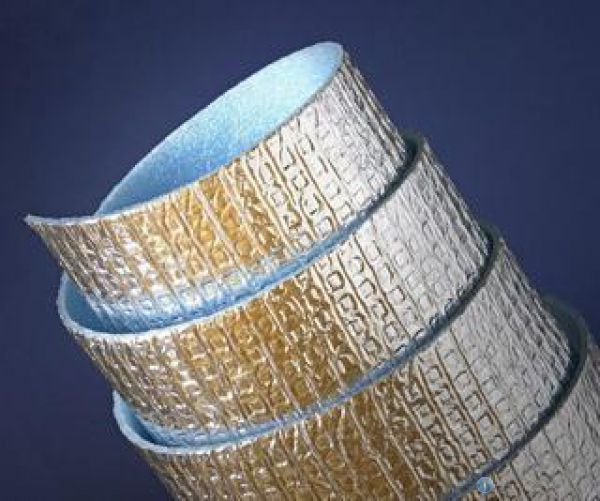
Advice! There are several classes of products: A, B and C. Class A insulation has foil on one side, and B series material has two. Insulation class C on one side has a foil base, and on the other - an adhesive layer, which makes it easier to install in inconvenient areas.
Application area
Penofol has versatility: it is used for insulation and vapor barrier not only of residential premises, but also of industrial facilities. That's far from full list where this material is used: 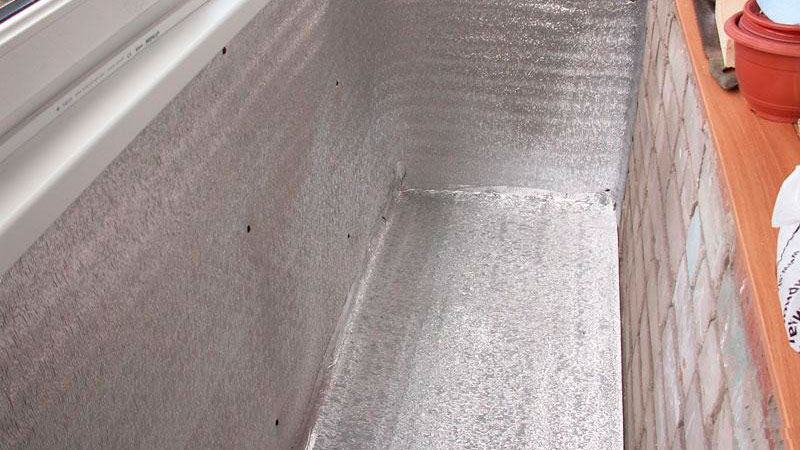
- Ceiling slabs.
- Wall insulation.
- Waterproofing and insulation of floors.
- Arrangement of warm balconies and loggias.
- Thermal insulation of air ducts and technical pipelines.
- Application in the automotive industry for thermal insulation of bodies.
As you can see, the list of applications is quite extensive. We will consider where you can use penofol with your own hands - a home area of \u200b\u200bapplication.
Penofol application
Even for household needs, this versatile material is used quite extensively. Let's consider the main directions.
Most often, penofol insulates floors in wooden house... This process is absolutely simple, you can easily do it yourself, just stick to this technology: 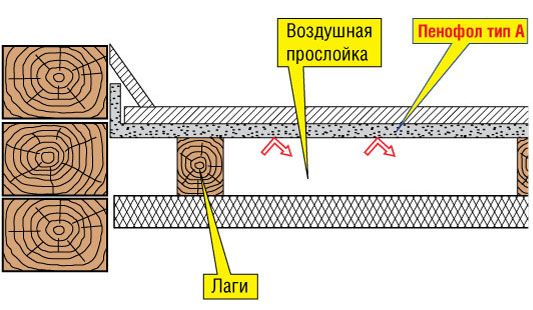
- It is best to remove the old boards and lay several layers of foam foam between the logs. In this case, all layers of material must be laid with a foil base inside the room. Then old boards are laid in place or a sheet of plywood is stuffed.
- Another way is to lay the heat insulator on top of a wooden covering. One layer of insulation is used, while the laying is done end-to-end, and the seams must be glued with aluminum tape. Then plywood sheets are laid on the laid heat-insulating layer and screwed to wooden base self-tapping screws.
Advice! It is impossible to fix penofol to a wooden base mechanically, for example, with staples. If there is a need to fix the insulation, it is better to treat it with glue or use an adhesive-based material.
Thermal insulation of concrete floors
As a rule, penofol for insulation of concrete floors in a house or on a balcony is used in conjunction with other types of thermal insulation materials. In this case, the technology of work is as follows:
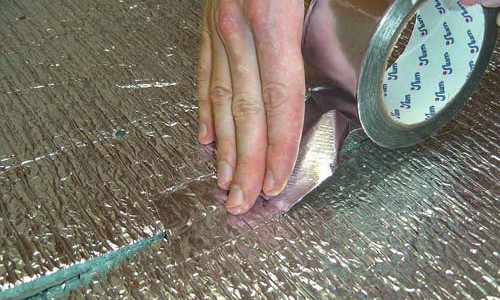
The use of penofol in the underfloor heating system
The use of penofol is very common when arranging a system of underfloor heating, both in a private house and in an apartment or on a balcony. The use of this reflective material increases the heat transfer of the entire system by 15–20%, which is a significant savings at the current cost of energy carriers. Penofol is used when installing warm floors using the following technology:
- After the main insulation has been laid, foil material is mounted on it.
- At the same time, general rule: installation is carried out end-to-end, the seams are sealed with aluminum tape.
- For this option, the one-sided option is usually used. If you need to fix the reflective layer, you can use foam foam with an adhesive base.
- Then an electrical cable or a water circuit pipe system is mounted on the foil.
Advice! You can cover the heating elements of the underfloor heating system not only with boards or plywood, but also pour cement screed... Foil base of penofol is resistant to various aggressive operating conditions.
Having studied the properties and familiarized yourself in more detail with such a material as foil-clad penofol, it is easy to agree with the opinion of professionals that this material is an excellent addition to existing insulation technologies. In addition, this insulation can be used as an independent heat insulator.
On the construction market there is a multifunctional material - Penofol, which, with a minimum thickness, provides almost 100% result. It is used for heat and sound insulation of buildings of any type.
It can act as an additional or independent layer.
- Insulation Penofol
- Penofol application
- How to insulate with Penofol
Insulation Penofol
The range of Penofol allows you to use it in individual houses, civil buildings and industrial buildings:
- insulation of walls, floors, ceilings, attic and mansard rooms;
- insulation of pipes in water supply and heating systems;
- insulation of equipment in various industries, including agriculture, medical and food production;
- ventilation and air conditioning systems;
- insulation different types installations used for the transportation of cold and hot food;
- rooms with high temperature conditions (drying chambers, baths, saunas, etc.);
- heat and sound insulation of bodies of cars and trucks;
- this versatile material is widely used in underfloor heating systems.
Penofol photo
Foil insulation Penofol
The composite material consists of a base layer, i.e. porous polyethylene with one or two-sided metal sheet (foil) coating. Its uniqueness lies in the simultaneous execution of several functions at once: convection and heat reflection. Thus, with a small thickness of Penofol, it is possible to achieve tremendous heat and sound insulation. The material is produced in rolls. Sheets can have a thickness of 3 to 10 mm.
The comparative table presents different kinds building materials that can achieve the same result. Penofol type B with a thickness of 4 mm is equivalent to:
Advantages
- Ecological cleanliness. The raw materials for production are polyethylene and foil, which for many decades have been successfully used in the food and medical industries.
- A thin layer of material guarantees high thermal resistance values. Penofol sheet with a thickness of 4 mm is equivalent to 2.5 brick masonry;
- High vapor permeability ensures free release of excess moisture. The absorbency of the material is zero, so it can be used in rooms with high humidity levels. Also foil-clad polyethylene foam is used for outdoor use.
- The material is characterized by excellent sound insulation properties. It will protect the structure from acoustic and structure-borne noise.
- The light weight of the sheets ensures quick installation. Due to its elasticity, the material fits perfectly on any surface. Routing can be done with a regular kitchen knife. Fastening is carried out by means of self-adhesive aluminum tapes, furniture stapler.
- Non-flammability. Fire-technical characteristics state that the presented material belongs to low-flammable and hardly flammable groups (G1 and, accordingly, B1). With prolonged exposure to open fire, the sheets may slightly smolder (smoke-generating ability D2).
- Convenience during storage and transportation. Lightweight and flexible canvases are rolled into compact rolls that fit even in the trunk of a car.
disadvantages
- The softness of foamed polyethylene has a beneficial effect on installation, but negatively manifests itself in the further decoration of the building or room. The surface is not intended for plastering or wallpapering.
- Despite the high physical and technical characteristics of the material, it is used in most cases as an additional layer. To achieve an effective thermal insulation result, it is recommended to use it in combination with other types of insulation.
Penofol video
Penofol application
The manufacturer has presented several modifications, letter designation which informs about its features.
| a type | Thickness (mm) | Length (mm) | Width (mm) | specifications | scope of application |
| AND | 3,4,5,8 and 10 | 1200 | foamed polyethylene with one foil side | It is mainly used for insulation of walls, attics and attics together with other types of insulation. This material is widely used for insulation of engineering systems. | |
| AT | 3,4,5,8 and 10 | With a thickness of up to 5 mm - 3000 mm; 8 and 10 mm - 1500 mm | 1200 | Foamed polyethylene base with double-sided foil | Effective as an independent insulation for floor slabs and interior walls, partitions |
| FROM | 3,4,5,8 and 10 | 600 | One side of the polyethylene foam is covered with aluminum foil, the other with a self-adhesive layer. Installation is carried out without the use of additional fasteners | Used to insulate complex structures, optimal for hard-to-reach places | |
| LSA | 3 | 3000 mm | 600 | The base is covered with foil on one side. Foil side laminated with polyethylene film | These products provide reliable protection from corrosion processes. Perfect for use in underfloor heating systems |
Today, products are produced in other modifications, for example, with a reinforced base (fiberglass) or additional perforation, which are intended for external insulation of building structures.
How to insulate with Penofol
- It is quite simple to mount the canvases, fastening to the surface is done using staple staples or adhesives. The sheets have an end-to-end joint, however, overlapping up to 10 cm is allowed. The foil side should face the interior of the room, house, pipe, etc.
- Particular attention should be paid to insulating the wiring, as aluminum is a good conductor of electricity. Plastic ducts or corrugated pipes can be used here.
- The basic rule that must be followed without fail is the presence of a ventilation gap of 1.5-2 cm on both sides of the material. This is due to the fact that the polyethylene base is absolutely waterproof, therefore, the inevitable moisture that occurs during the operation of the structure will accumulate and moisten other structural elements.
- Mounting joints or accidental cuts in the canvases are glued with self-adhesive aluminum tape (LAS or LAMS). Mounting tape provides complete vapor and waterproofing of the system.
Insulation of walls with Penofol from inside the room
Internal wall insulation will prevent the formation of moisture, and hence the development of mold and mildew. The works are carried out in the following order.
- Rails with a thickness of 1.5-2 cm are mounted on the surface in a vertical position, this characteristic will provide the required ventilation gap. The step between the bars should be 600 mm. Since the width of the canvas is 1200 mm, this indicator is optimal for the installation of insulation.
- Laying is done with the foil side inside the room. The edges should be in the middle of the strip. The next sheet is located end-to-end to the previous one. The optimal fastener is a construction or furniture stapler, you can use small nails.
- The length of the canvases is cut using a ruler and a sharp knife or blade.
- All connecting seams are glued with a special tape, which will ensure complete sealing between the sheets.
- The next step is to re-install the rails. Their location is selected depending on the characteristics of the subsequent finishing materials. The wooden frame can serve as the basis for attaching panels made of plastic or wood, as well as gypsum plasterboard sheets, which are putty and then painted or pasted over with wallpaper.
Installation of Penofol outside the building
Experts say that the most effective way insulation is installation thermal insulation material outside. The perforated modification of Penofol promotes the free removal of steam and moisture emanating from the building. In addition, the material protects the walls from wind and precipitation, and provides a high level of sound insulation. An important advantage of outdoor installation of insulation can be attributed to saving usable floor space.
- Insulation is recommended in dry, warm weather. The surface is cleaned of previous coatings, dust and dirt. Then it is subjected to antiseptic treatment. Particular attention should be paid to the corners and lower parts of the walls, they are more prone to freezing.
- As with internal insulation, slats are mounted on the surface. Fasteners are selected depending on the material of the walls.
- The canvases are spread butt joint. Fastening is carried out with a stapler. The seams between the sheets, as well as the joints of their upper and lower parts to the walls, are glued with mounting aluminum tape.
- Next, the outer frame is equipped, which is revetted with profiled sheets, vinyl siding and other materials. If a brick acts as a facing, then there is no need for a re-frame. In this case, the masonry is erected at a distance of 30-40 mm from load-bearing walls providing the necessary connection, taking into account the features and nature of the structure being erected.
Penofol insulation of a cement floor
- Grade A material can be used as a substrate for parquet, laminate, linoleum. It will show high performance in heat and waterproofing, as well as sound absorption.
- To insulate concrete floors, a screed is first performed with a solution with the addition of expanded clay. However, dirty and time-consuming work can be avoided if this layer is replaced with sheets of foam plastic 5-10 cm thick, on top of which the canvases are laid with the foil side up.
- The edges should overlap all walls by 10 cm. The canvases themselves are laid without overlap. The seams are glued with aluminum tape.
- For the ventilation gap between the insulation and finishing material slats or lags are stuffed. Wooden elements are treated with antiseptics to prevent premature decay.
- An indent of 1-2 cm is made from the wall and the slats are mounted along the entire length of the room with a step of 40 cm. The horizontalness is checked with a building level or laser, if necessary, correction is carried out by laying chips.
- The edges of the insulation that protrude onto the walls are carefully cut off.
- Sheets of plywood (12 mm), fiberboard or chipboard are laid on top of the frame. Self-tapping screws are screwed in every 15-20 cm. The subfloor is covered with any facing material.
Installation of Penofol in the "Warm floor" system
- The presented material provides not only hydro and sound insulation, but also guarantees excellent heat transfer due to the reflective foil layer.
- Canvases of grade A or C are spread with foil top on the base butt-to-end with a mandatory spade on the walls (10 cm each). The joints of the material and accidental cuts are glued with assembly tape (LAMS).
- Next, the heating elements are laid. Bars are laid between them, which will serve as the basis for laying parquet, laminate or other piece products.
- In case the heating system is flooded sand-cement screed (under ceramic tiles), use a modification of Penofol - ALP. This type of material does not respond to hostile environments.
- Laying is done with a spade on the walls and a butt joint; seams are glued without fail.
- After installation of the heating elements, the system is checked for functionality. Then the reinforcing mesh is lined and filled concrete mortar... When the screed dries, the protruding edges of Penofol are cut off. .
Wooden houses built over 40 years ago had thick and massive walls. The massive foundation had to be poured, and a whole construction team had to be hired to mount the walls. But even with a sufficient thickness of the wall, it was necessary to insulate with the help of: moss, tow or straw with clay. Modern materials allow for insulation wooden house from the inside quickly and without much physical exertion. Mineral wool, foam and polyester began to be used more than 20 years ago, but modern markets offer lighter and practical materials... Penofol is one of these. How to insulate a wooden house from the inside with penofol, design features and installation in one article.
Penofol pros and cons
Penofol insulation is easier to perform, and due to the smaller thickness and high thermal insulation characteristics the material received a lot of positive feedback from users.
What is Penofol?
 Penofol is know-how in the world of materials for insulation wooden houses, loggias and baths. It belongs to reflective insulation with a top layer of a special polished foil material. The base is foamed PVC. The heat-saving properties of the material depend on the density, thickness and quality of the foam base. The foam base has a thickness of 2 to 40 mm. The most common for insulating a wooden house inside is 10 mm. The 40 mm material is used only in the northern part of Russia, where the climate is very harsh. From above (on two or one side) a foil is welded to the material, which is polished to a reflectivity of 97%.
Penofol is know-how in the world of materials for insulation wooden houses, loggias and baths. It belongs to reflective insulation with a top layer of a special polished foil material. The base is foamed PVC. The heat-saving properties of the material depend on the density, thickness and quality of the foam base. The foam base has a thickness of 2 to 40 mm. The most common for insulating a wooden house inside is 10 mm. The 40 mm material is used only in the northern part of Russia, where the climate is very harsh. From above (on two or one side) a foil is welded to the material, which is polished to a reflectivity of 97%.
A bit of history
The material was invented in the USA and used to make space suits. In Russia, they paid attention to the high thermal insulation properties of the material and began to use it in the construction industry. For the insulation of wooden houses, the material is used both inside and outside.
Insulation of a wooden house from the inside with penofol resembles a thermos in design. A wooden house, the walls of which are covered with foil insulation, retains heat in winter and cool air in summer. At the same time, the internal insulation does not block the flow of oxygen to the tree and the house does not stop breathing. And the thickness is several dozen times less than mineral wool or foam plastic, which made it possible to use insulation in the smallest rooms.
On the advantages and disadvantages of the material
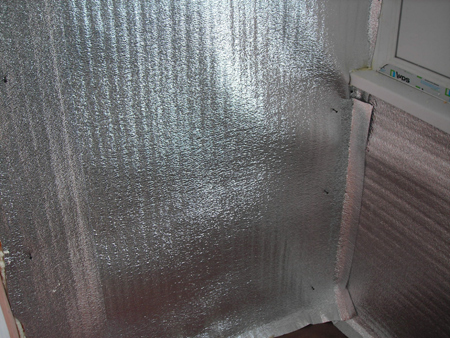 Insulation can be used in combination with other materials or independently. And its lightness allows you to easily carry out insulation with your own hands alone. Positive reviews about penofol insulation are associated with its advantages:
Insulation can be used in combination with other materials or independently. And its lightness allows you to easily carry out insulation with your own hands alone. Positive reviews about penofol insulation are associated with its advantages:
- Environmental friendliness. The material is made of film and foil used in the food industry. Some sources claim that it is capable of not letting in radiation, but this fact has not been proven.
- Greater thermal insulation with a lower layer thickness. According to scientific research, penofol with double-sided foiling with a thickness of 4 mm is comparable in its thermal insulation properties with mineral wool 10 cm, expanded polystyrene 4 cm and wood 18 mm.
- Since the material does not allow steam to pass through, installation can be carried out without additional thermal insulation of the structure.
- It does not pass or absorb moisture, therefore it does not spread rot and mold on the wood.
- It has high sound-insulating qualities, therefore, in frame construction, it is used to decorate children's rooms and bedrooms.
- Does not crumble or break, you can cut it with simple scissors or a sharp knife.
- Easily mounted on wooden walls of the house with small nails, construction foil tape or stapler.
- It does not burn, since it has a fire hazard class, it is difficult to combustible and hardly flammable.
- You can transport material in any passenger cars by oneself. It is lightweight and rolls into a soft roll.
- Due to the thin layer, rodents will not make holes in the material, as, for example, in foam or mineral wool.
- It is certified by specialists of the Sanitary and Epidemiological Institute, and is suitable for use in children's institutions.
Despite all the advantages of the material, there are many negative reviews. They are associated with such qualities:
- Softness. After installation from the inside of a wooden house, it is impossible to immediately plaster or wallpaper.
- It is difficult to mount with special glue, and using nails or a stapler, the material breaks through and loses some of its thermal insulation. You can only exclude group C, to which the insulation on one side is covered adhesive compositionlike scotch tape.
- Do not use it to insulate the facade, as the material will not release steam from the house and condensation will accumulate under the film. This will quickly destroy the walls.
With high-quality installation and proper insulation, pefonol insulation gives long-term protection to the walls, floors and ceiling of a wooden house. For each part of the structure, a material of a certain brand is used.
Insulation brands
Penofol is subdivided into A, B, C, ALP, AIR, M, R, NET by markings. The characteristics of each can be seen in the table:
| Brand | Characteristic | Appointment |
| AND | Has a thickness of foamed polyethylene from 2-10 mm, foil layer on one side only. | They are used to insulate walls, floors, ceilings from the inside of a wooden house or outside, together with foam. |
| AT | The thickness of the foam is from 2 to 40 mm, foil on both sides. | Insulation of any part of a wooden house from the inside and outside, both with other insulation materials, and independently. |
| FROM | The thickness of polyethylene foam is from 2 to 40 mm, foil-coated on one side, on the other there is a sticky base made of moisture-resistant glue. | Suitable for insulation from the inside of the house, it is easily mounted without additional fasteners. |
| ALP | Thickness is from 2 to 40 mm, foil-coated on both sides, polyethylene is welded onto one side of the foil, it is called laminated. | They are used for insulating any parts of the building in a slightly aggressive environment. |
| AIR | Thickness is from 2 to 10 mm, the foil part has increased strength. | Used for insulation of ventilation systems and pipes. |
| R, M | Thickness from 2 to 10 mm, foil-coated on one side, embossed surface. | Suitable for insulation wooden walls outside and inside. |
| NET | Thickness 2-10 mm, extra strong foil on both sides. | They are used for insulation of the communication system in a wooden house: power grid, wells, pipeline, sewage. |
If the brand is selected correctly, then the thermal insulation will simply be done by hand. For wooden walls, you can use corrugated insulation and A, B, C. The latter is easier to attach to a vertical surface, but if the walls are old, then it will not be glued well.
You can find Penofol 2000 in hardware stores. This brand is made from materials of inferior quality, so the price is lower. But it is not recommended to use it to insulate the walls of a wooden house, since the strength of the insulation is low. You can find a combination of several brands at once; it is not difficult to find out about the characteristics of a heat insulator knowing the above basic ones. Acquire material by calculating the size based on the area of \u200b\u200bthe walls.
Indoor installation
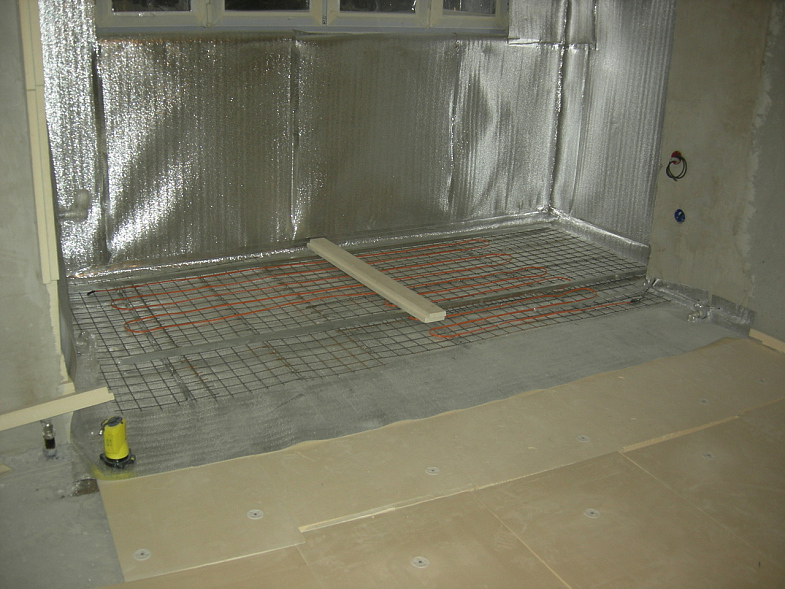 From the inside of a wooden house, insulation is used for thermal insulation of the following structures: walls, ceiling, floor, attic, basement or basement. Due to the non-penetration of moisture, it can be used in damp and dry rooms. Pe rules:
From the inside of a wooden house, insulation is used for thermal insulation of the following structures: walls, ceiling, floor, attic, basement or basement. Due to the non-penetration of moisture, it can be used in damp and dry rooms. Pe rules:
- The foil side of the penofol is laid to the side where the body should be reflected, that is, into the room.
- For better thermal insulation between the wall and the material, a ventilated gap of 1.5-2 cm is left. The same is done between the insulation and the outer wall decoration.
- To achieve complete sealing, the seams are glued with a special foil-clad construction tape.
Wall insulation technology
Thermal insulation of a wooden house from the inside with penofol is carried out according to the following scheme: a wall, a space of 1.2-2 cm from the lathing, insulation, lathing, external decoration, for example, gypsum board or gypsum plasterboard. A more detailed diagram and design are presented in the video and photo in this article.
The work is carried out in stages:
- Bars with a thickness of 15-20 mm pre-treated with an antiseptic are attached to the wall. Any step of the lathing, but not more than 1 m.
- Penofol is attached to the crate. This is easier to do with a stapler or small studs. Laying is done end-to-end. They are glued with foil tape.
- A counter lathing from a bar of a smaller or the same section is attached to the material. The bars are fixed in the opposite direction to the first batten.
- Any panels (block house, imitation timber, lining) or sheet material (gypsum board or gypsum plasterboard) are attached to the top of the crate.
- The walls are plastered and painted or pasted over with wallpaper.
It is not difficult to carry out thermal insulation with your own hands. the main thing is to follow all the stages. The video and photo materials in this article will help even a beginner to cope with the work.
Price for material and work
The price of material and work depends on the volume of the order, the complexity of the design, the quality of the insulation. The stacking scheme is not complicated, but a qualified team will take more for work than advertised. The average cost for professionals in major cities is shown in the table:
It is cheaper to buy material in bulk. To insulate a wooden house from the inside is expensive to use, but insulating a bathroom, a nursery and a bedroom costs no savings.
The essence and features of Penofol heat-insulating material, its area of \u200b\u200bapplication, advantages and disadvantages, surface preparation, internal wall insulation algorithm, final finishing.
The content of the article:
Insulation of walls with Penofol from the inside is a technology that is gaining more and more popularity for various reasons. It's believed that this material has truly unique characteristics and is extremely easy to use. With its help, it is possible to achieve the preservation of an optimal microclimate in the room due to not only insulating, but also reflective qualities.
Features of Penofol and its insulation from the inside
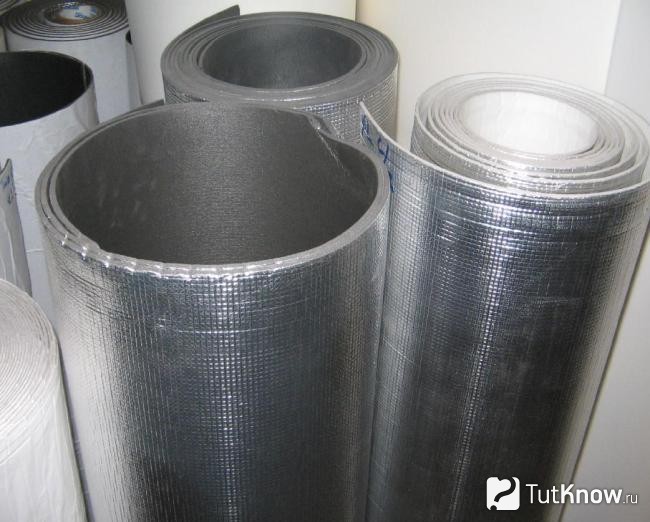
Penofol belongs to the category of very thin polymer-based heaters that are produced using the foaming process. The base is polyethylene foam, which can have various thicknesses, structures and densities. The material owes its name to it.
Subsequently, a layer of reflective aluminum foil is attached to the layer of such polyethylene. It can be fixed on one or both sides, polishing it to such an extent that the reflection coefficient reaches 97%. It is applied by heat welding.
The Penofol manufacturing technology gives it a closed structure, which is why this insulation is not able to pass moisture and water vapor. As for the foil, its main task is to reflect back the heat flows passing through the room.
The insulator resembles a classic thermos by the principle of operation. If you insulate the walls from the inside with foil-clad Penofol in the house, then in the cold months it will keep it warm, and in the summer months - cool. If other heat insulators keep the heat that comes out of the room, then the material with an aluminum layer reflects it.
Insulation of walls with Penofol from the inside can be done in one of 3 types of this material: type A - foil on one side; type B - foil on both sides; type C, where on one side there is an adhesive base, and on the other - foil. One of the most popular last types can be considered Penofol, pasted over with foil on one side, but at the same time many small holes are punctured in it. Such a perforated material becomes vapor permeable.
Penofol is produced in various thicknesses - from 3 to 10 mm. In some cases, when material is required for harsh climatic conditions, the thickness can be increased to 40 mm. Its ultimate strength during compression is not less than 0.035 MPa.
The scope of this heat-insulating material is internal insulation of residential and industrial premises, including walls, as well as balconies and loggias. The range of temperatures at which it can be used is from -60 to +100 degrees Celsius.
Penofol has proven itself as an independent heat insulator or a middle layer of insulation when protecting baths, attic spaces, showers, basements. With its help, heat reflection of household batteries, insulation of floors and pipelines, as well as various communication systems are produced.
Truly effective results in insulation can be achieved by combining Penofol with other materials. The combination with other heat insulators allows you to increase the layer thickness, which will create the necessary margin of safety for severe frosts. The Penofol foil itself perfectly reflects moisture, as a result of which the entire structure is operated for a long time.
Pros and cons of wall insulation with Penofol from the inside
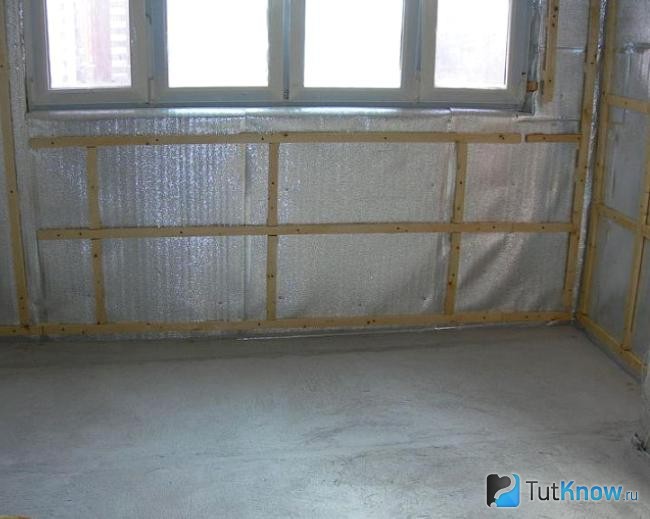
The material has more than enough advantages - it is not for nothing that it has become so widespread. Let's name the following positive qualities:
- Saving usable floor space... This became possible due to the small thickness of Penofol compared to other insulation materials. At the same time, it can replace heat insulators with a thickness ten times greater.
- Good thermal insulation... Provided by the reflective ability of the material.
- High degree of environmental friendliness... The insulator is practically non-toxic, because it is made on the basis of aluminum foil and polyethylene, which have long been used in the food industry.
- Fire safety... This quality is due to the fact that Penofol is classified as a flame retardant material.
- Low vapor permeability... In this case, it does not matter what the weather is outside the window, since moisture is not absorbed by the insulation.
- Sanitary safety... Penofol is considered a material that is difficult to reach for rodents.
- Easy to transport... This is due to the fact that the heat insulator is rolled up and easily transported.
- Excellent sound insulation... If this material is mounted on the main structure, it will help protect against acoustic noise.
- Ease of installation... Penofol can be easily cut with any knife, and you can fix it not only with small nails, but even with tape. But at the same time it is difficult to break or crumble.
- The need for an additional layer that will help in reflecting heat energy and protecting against moisture ingress.
- The lack of sufficient rigidity does not allow using it under plaster or wallpapering. The material can be pressed through with light pressure.
- The need to use special adhesive mixtures, since the insulator is not recommended to be nailed to the wall - from this it loses some of its thermal insulation qualities.
Penofol insulation technology for internal walls
Depending on the characteristics of the room and the method of thermal insulation, the appropriate type of Penofol is selected. Some of them can be mounted autonomously (type B), others serve as waterproofing of a more powerful insulation (type A), and still others act as the basis of the thermal insulation layer (type C). This material successfully allows the surface to breathe without accumulating moisture. It relieves walls from the appearance of mold and mildew that arise after steam ingress.
Preparatory work before thermal insulation of walls with Penofol
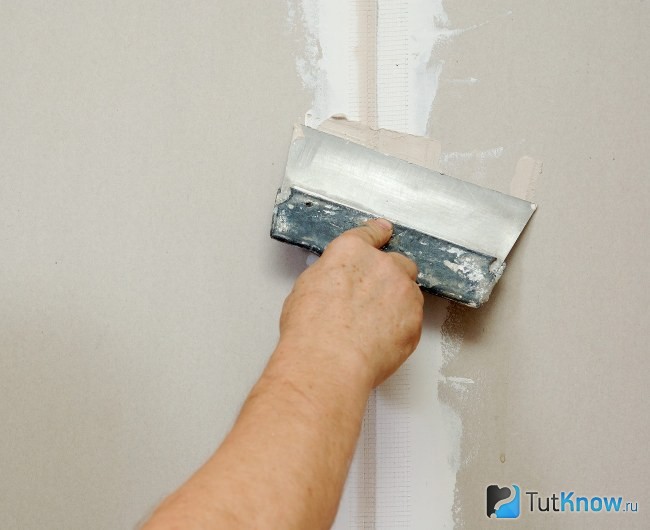
Before starting laying Penofol, be sure to check the quality of the wiring in the room. Unlike other thermal insulation materials, it contains aluminum foil, which is known to have good electrical conductivity. Protect the wires to prevent the insulation from coming into contact with bare cables.
It goes without saying that the work surface is prepared - they clean off the debris, carry out cleaning with an emery cloth. If necessary, fill up the cracks with a filler solution. It is also advisable to buy a primer paint and paint over the wall, which will allow you to get a perfectly flat surface.
Of the tools and devices for work, we need:
- Well sharpened knife;
- Furniture (construction) stapler with staples to it;
- Ruler;
- Level;
- Pencil;
- Construction trowel;
- Hammer;
- Working deep container for solution;
- Emery cloth of varying grain size;
- Screwdriver;
- Roulette;
- Dowels;
- Electric drill.
Installation instructions for Penofol on walls
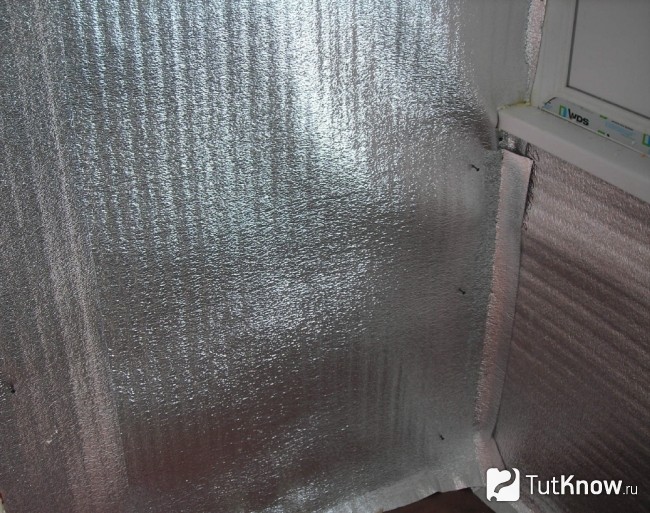
Armed with necessary tool and using the help of another person, carry out the following actions:
- Initially, a wall-mounted wooden frame... Its task is to enhance the effect of the use of heat-insulating material. For fixing the bars, dowels are taken, which are hammered in no wider than 1 m from each other.
- Penofol is fixed on the frame with a furniture stapler. For this, the material is cut into strips with a sharp knife. The strips are not overlapped, but end-to-end, so that condensation does not form along the joint line. Seams can be glued with special tape.
- After that, another frame is attached, at a distance of 2 cm. This is done in order to allow air circulation. Now it can be covered with cladding panels, putty or wallpaper on top.
A common mistake associated with improper installation of insulation: some craftsmen mount Penofol directly on the ceiling or wall, leaving an air gap on only one side. This leads to a decrease in its thermal insulation characteristics.
Important! When installing Penofol, its foil part must necessarily look inside the room, and not at the wall. This is a prerequisite for additional heat reflection.
Finishing the walls

After you lay the heat insulator, cover the top with crate and wood boards, you can proceed to finishing surface. You need to start by leveling it: any defects that may interfere with the reliable attachment of the plaster or the gluing of a roll of wallpaper are removed. It is best to clean uneven surfaces with emery, starting with a coarse grain and ending with a fine sandpaper, which makes the surface even and smooth.
Most often, a plaster solution is applied to the finished wall, which can then be painted or decorated in other ways. The most common are cement or gypsum-based plaster mixes. At the same time, gypsum is not subject to shrinkage over time, it is distinguished by good plasticity and bonding properties. It does not require the use of a reinforcing mesh.
If you don't have enough experience in plastering walls, you can purchase plaster signaling devices that will be limiters - they allow you to measure the thickness of the layer and protect against unevenness. After fixing the signaling beacons on the working surface, you can start preparing the solution.
Take a bucket or other container, fill it with water about a third. Add the solution gradually and stir constantly to achieve a homogeneous mass. The mortar should be of such a consistency that it does not run off the spatula, and its density will depend on how thick the plaster layer should be.
If the walls in the room absorb moisture strongly, they must be additionally moistened. For these purposes, a household spray gun is well suited. This is done so that the solution retains its moisture, otherwise it will crack after drying.
The plaster is applied to the wall by applying it with a spatula. If such skills are difficult to master at first, then you can apply the solution to a wooden trowel and level it on the surface. Alignment is performed from bottom to top. If plastering is carried out in the area of \u200b\u200bthe slopes of window and door openings, then it is better to apply the solution with a slight overlap.
Using the rule, you can remove the excess solution. Its sharp edge is directed perpendicular to the plaster beacons. You should start from the lower border. Gradually, the instrument is raised higher and higher and the excess solution is removed, throwing it up. After that, the final smoothing of the wall is carried out. This is done several times to achieve a flat surface.
In order to make sure that the surface is flat, the rule is applied at various angles. The resulting bumps are scraped off with the sharp edge of the instrument. It remains to pull the beacons out of the wall with a screwdriver. Now you can grout or paint the plaster. On this, the insulation of the walls with Penofol from the inside can be considered complete.
Thermal insulation of wooden walls with Penofol
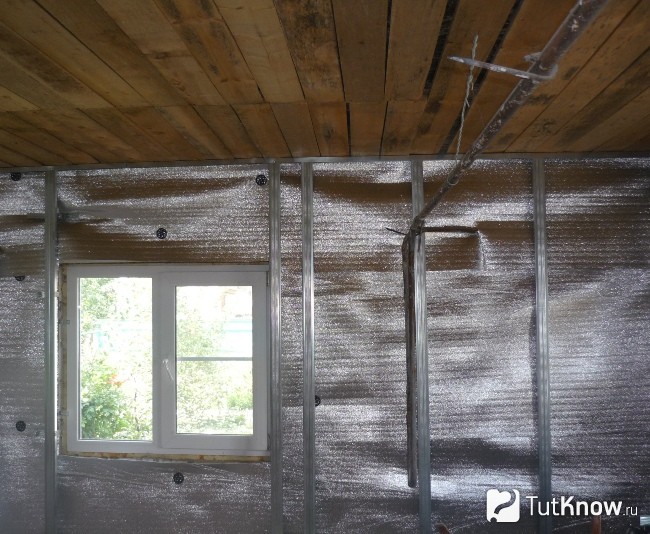
In this case, the work is somewhat different, since the tree itself is already warm material... But, despite the fact that such a surface has a "breathing" ability, retains heat and contributes to the creation of a favorable microclimate, warm air can still seep into the street.
During operation, the wood undergoes some shrinkage under the influence of natural and climatic factors. This causes the appearance of fresh cracks, cracks, and other unfavorable places. The tightness is broken, which leads to the need to apply a heat-insulating layer.
Before carrying out insulation work on wooden walls, you need to make sure what kind of wood they are made of. This is due to the fact that different varieties and types of wood differ in different characteristics for thermal insulation. All this leads to the fact that the cost of insulation may be different.
It is the lack of external insulation that leads to the need for internal wall insulation. Penofol in this case is perfect, especially if you combine it with other materials.
Insulation of a wooden house is carried out according to the following algorithm:
- Thermal insulation of wooden walls from the inside with Penofol should be started by sealing the cracks and gaps that are naturally formed in the wood. It is recommended to pay special attention to checking joints, window frames, door frames, corners.
- Making a frame for a heat insulator for wooden walls is optional.
- If Penofol sheet with one-sided foil is used, then it is the side with the foil that should face the crate, that is, inside the room.
- A sharp knife is used to cut the strips.
- The strips are attached using special staples and a powerful construction stapler. At the same time, they should be in close contact with each other so that there is no free space between them.
- To fix the joints, they are glued with aluminum tape. This will provide an even and uniform reflective surface.
- Preservation of the air gap is a must for effective insulation and the absence of condensation. Air space must flow between the material and the wall.
- On top of the insulator, wooden blocks are stuffed, which will serve as a crate. They can be used to attach chipboard sheets or plastic panels... The final finishing is the same as in the case of concrete walls.
Note! It is necessary to carry out work on the internal insulation of a wooden house after the final shrinkage of its walls and foundation occurs. This usually occurs no earlier than a year after the completion of all construction work.
How to insulate walls from the inside with Penofol - watch the video:
Penofol's attractiveness as a heater is largely due to its unique properties. However, one should pay tribute to its value, which fluctuates in ranges below the market average. Simplicity of installation will also save money, because you can perform thermal insulation of internal walls on your own.
All large quantity owners of private houses and developers of apartment buildings insulate the walls with penofol. It is especially important to properly protect the premises located in the corner of the building. The material is in no way inferior, and in certain cases even superior, to other popular insulators. Below we will figure out what its peculiarity is.
An important and essential point when using a component is its minimum thickness, due to which, in the final stage, the space practically does not lose its useful volume and area. The material is allowed to be applied as a separate thermal insulation from the inside, and used in combination with elements of other design.
The structure of the product is three-layer. On the outside is aluminum foil, and polyethylene is used as an intermediate layer. Usually the thickness finished product no more than 10mm. The principle of operation of the insulation is not in the absorption of energy, but in its reflection. Great for keeping warm and cold.
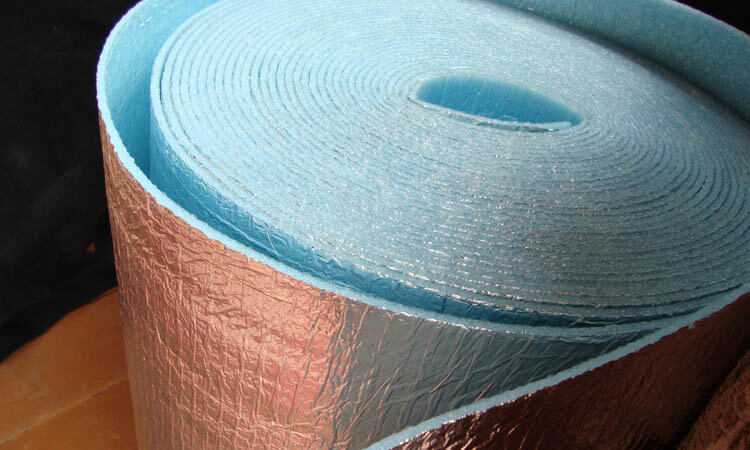
Figure # 1. Penofol insulation
Penofol is great for:
- 1. Insulation of the house piping system.
- 2. Thermal insulation as the main component of floor, ceiling or wall decoration.
- 3. Soundproofing the room.
- 4. Waterproofing and vapor barrier of steam rooms, baths and saunas.
- 5. Protection of ventilation ducts.
- 6. Insulation of all types of floors.
- 7. As reflectors for heating radiators.
Among the main advantages of penofol, it should be noted:
- 1. Ease of installation, ease of cutting and application to any type of surface.
- 2. Environmental safety and harmlessness, since it is based on food foil and polyethylene.
- 3. Resistance to ignition.
- 4. Minimum thickness (only 4mm of material is equivalent to 100mm of mineral wool in its properties).
- 5. Ability to absorb noise.
- 6. Low level vapor permeability, due to which, when insulating a house, there is no need for vapor barrier.
- 7. Not of interest to small rodents and microorganisms.
- 8. Delivered in rolls, which has a positive effect on its transportation and stacking.
- 9.Fits all sanitary standards and requirements.
Among the disadvantages are:
- 1. The impossibility of using it as an independent insulation for the outside of the house, so it is often used as waterproofing.
- 2. Difficulty fixing with glue solution, so you have to use alternative methods. At the same time, installation by means of nails is strictly prohibited, since the integrity of the penofol will be violated.
- 3. Poor manufacturability for plaster finishingbecause the component is soft enough and does not hold its shape.

Figure # 2. Foam insulation
Competent thermal insulation of walls or floors with foil foam foil can only be carried out in compliance with the following rules:
- - the best effect will be achieved with a guaranteed air space between the material and the surface of the wall of the house;
- - it is recommended to seal the joints with aluminum tape;
- - the reflective side must face the interior of the room;
- - the material should not be overlapped, since its thermal insulation qualities are noticeably reduced.
Violation of at least one of the listed points in the short term can lead to an unplanned premature rework of all insulation.
Warming the room from the inside
It is possible to carry out construction work even on our own, for which it is necessary:
- - foil-clad penofol;
- - stapler or assembly glue;
- - wooden lathing;
- - hardware;
- - insulation of electrical wiring;
- - Decoration Materials.
Video # 1. Wall insulation with penofol
Execution technology
- 1. A wooden frame made of beams is knocked down, observing an air gap of 20mm.
- 2. Using an adhesive, the material is fixed to the frame. The use of a stapler is allowed.
- 3. Wiring is insulated, if necessary. This is imperative, since foil is an excellent conductor, which can lead to serious consequences in the event of a short circuit.
- 4. A second wooden frame is installed, the thickness of which is 20mm, which serves as the basis for the application of finishing components.

Figure №3. Wall insulation with penofol
External insulation of the room
Protecting walls from the outside differs significantly from the technological process of isolating a room from the inside. For work, in addition to the list presented in the previous section, waterproofing and materials for the external facing of the building are also required. Strictly speaking, our experts do not recommend using penofol for external insulation or using it as an additional heat insulator in combination with another, for example, mineral wool.
Execution technology
- 1. Before starting the application of thermal insulation, thorough cleaning and processing of the walls of the facade of the building are performed.
- 2. The steps for applying the material are similar to how it is done from the inside. The difference lies in the construction of an additional frame to which the waterproofing is fixed.
- 3. The facade cladding is mounted on top of the waterproofing on a wooden frame.
Thermal insulation of the floor using penofol
It is difficult to achieve a comfortable and favorable atmosphere in your home without floor insulation with penofol.
It is usually used as an additional insulating layer.
The key material is often expanded clay or foam. To carry out the work you will also need:
- - foil-clad penofol;
- - basic thermal insulation;
- - wooden or metal lathing;
- - assembly locksmith tools;
- - hardware or adhesive solution;
- - wooden logs.
Video number 2. Floor insulation with penofol
Execution technology
- 1. The floor is leveled with a concrete screed to ensure a level surface. Additionally, it is recommended to lay the main insulation under the insulation.
- 2. Penofol is fixed on the screed, ensuring the trimming tolerance at the walls is at least 100mm.
- 3. A metal or wooden frame is mounted. In the case of a wooden floor, experts advise replacing the frame with logs, impregnated with an antiseptic solution.
- 4. Penofol is attached to the rails.
- 5. A wooden frame is laid on top of the insulator.
- 6. In the final phase, the cladding is laid down.
It is worth noting that insulation work on the floor in this way will lead to a decrease in the height of the room. In this regard, it is better to make a frame from a bar with a thickness of no more than 15 mm.
Ceiling insulation
Penofol allows you to insulate the ceiling with high quality and in the best way, since the material has a small thickness and low weight. In addition, its installation will require minimal effort.
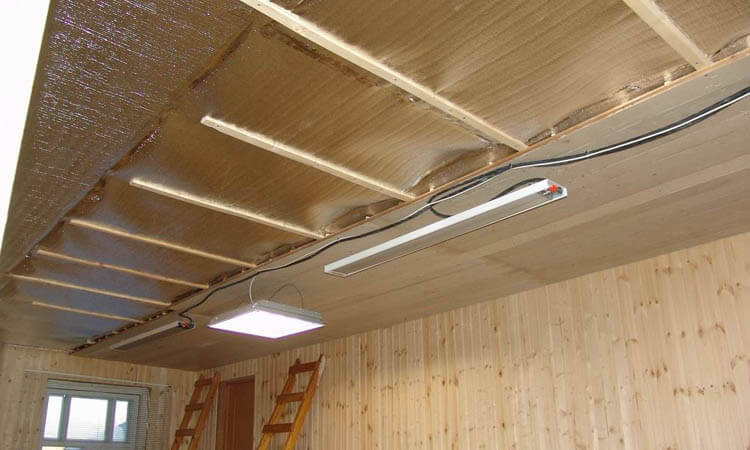
Figure №4. Insulation of the ceiling with foamed insulation
Before insulation, you will need to take care of the presence of:
- - penofol;
- - wooden slats;
- - hardware;
- — locksmith tool;
- - cladding.
Execution technology
- 1. Thermal insulation of the ceiling surface is provided in two steps. The initial layer is fixed to the ceiling by means of strips in the longitudinal direction. The next layer is similarly in the transverse direction, with the material coming out onto the walls within 100mm. The slats are fixed with self-tapping screws.
- 2. On top of the installed layers, a cladding of plastic, foam or other lightweight component is installed.
Conclusion
As can be seen from all that has been said, it is not difficult to carry out work on insulating a building with penofol, and you can really do it yourself. To achieve a positive result, it is important to comply with the technology for performing work and have minimal skills. Otherwise, it is better to use the services of specialists.



